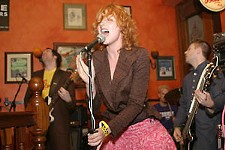Three on a Match
Three childhood friends experience tragedy as adults when one of them runs away with the gangster boyfriend of another.
Reviewed by Jerry Renshaw, Fri., June 8, 2001
Three on a Match
D: Mervyn LeRoy (1932); with Bette Davis, Ann Dvorak, Humphrey Bogart, Joan Blondell, Warren William.
If three people light cigarettes from the same match, one will die soon, or at least that's how the old superstition has it. Three childhood friends (Blondell, Davis, Dvorak) laugh it off as they all light up from the same match. Vivian (Dvorak) is married to a wealthy attorney (played by William, in a sympathetic role for once). Bored and stifled in her life, she decides to walk on the wild side; absconding with their four-year-old son, she falls in with gangsters and takes a nosedive. Soon she's living the life of a slattern, hooked on cocaine and bootleg liquor, neglecting her son like he's so much excess baggage. Meanwhile her husband and friends are frantic to get the little boy back and set things right again. In this movie's 64-minute running time, director Mervyn LeRoy managed to include Depression-era social commentary, drugs, crime, Prohibition, sex, violence, and some surprisingly well-fleshed-out characterizations. The young Davis is beautiful (even playing one scene in her lingerie), and Blondell and Dvorak are both great in their roles. Ann Dvorak was a very beautiful and talented actress who's been almost forgotten over the years, and her work in this film points out just how good she could be. Even more remarkable, though, is the number of future stars that can be spotted in Three on a Match; Lyle Talbot, a young Anne Shirley, Edward Albert, and Humphrey Bogart in a great role as a menacing hood. This is entertaining fare that's still potent today in all its pre-censorship seediness. Though its plot turns seem a little bizarre (mainly because the narrative is so compressed), it's a fine example of the type of content that the Hays Code would vacuum out of movies a couple of years later.










